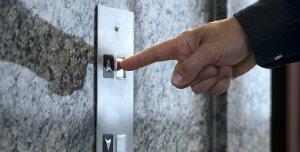Putting a Finger on Building Occupant Health and Safety

The next time you press the elevator call button at your office pause and ask yourself, “Where has my finger been?”
Now, think about where all of the other fingers that have pressed that same button have been. Are you thinking about taking the stairs? That may be the healthier choice, but only because of the extra exercise and not because you avoided a germ hotspot in your workplace. In fact you may be coming in contact with the dirtiest places in your workplace without knowing it. Fortunately, the key to a cleaner, healthier work environment comes down to common sense maintenance.
A 2014 study found that the most unhygienic spot in your office building is not the elevator. It isn’t even that unpleasant smelling public bathroom you always try to avoid, but it just might be your desk. According to the report by Initial Hygiene, a provider of commercial hygiene products, the average office desk has 400 times more bacteria than a typical toilet seat. And the office phone is the most contaminated object on an office desktop, with 25,127 microbes per square inch.
Now that I’ve got you afraid to pick up the phone too, you might be asking yourself how you can function while avoiding contact with all the potentially dirty items you touch every day. You also might ask when was the last time those things were cleaned as opposed to the public bathrooms that generally are cleaned and disinfected nightly by your building’s janitorial crew. That also makes the 2.2 days, Initial Hygiene found the average worker spends avoiding what they perceive as unhygienic places, like waiting in line for the cleanest toilet, seem pointless and a little silly.
Workplace cleanliness is serious business, however. The Centers for Disease Control and Prevention reports that between 5 percent and 20 percent of the U.S. population contracts seasonal influenza each year. That results in an estimated loss of 70 million work days, which will contribute to more than $10 billion in lost worker productivity annually.
Don’t break into a sweat over being surrounded by disease-causing germs in your workplace. Seriously, don’t do it. The salt from sweaty hands can corrode and oxidize brass door handles and water taps to reduce the metal’s natural bacteria-fighting properties, according to a 2014 study by researchers at the University of Leicester. The answer to a healthier work environment is simple: smart, sustainable maintenance practices. For example, people have attributed poor indoor air quality to the simple presence of carpet, which gets saturated with the contaminants that become airborne with use and foot traffic. This belief caused many to tear up carpets and replace it with hard surfaces. But these beliefs are based on old data.
A January 2014 study by Airmid Healthgroup concluded that “effectively cleaned carpet has the capacity to trap allergens and microbial particles, making these particles less available to become airborne and thus maintaining [enhanced] indoor air quality.”
Tests of various flooring types, including hard surface floors, found that airborne concentrations of various allergens “were lower with carpet as opposed to the hard surface floors” because of carpet’s ability to trap airborne particles and a proper cleaning and maintenance program results in a healthier overall environment. Good regular maintenance is only part of the puzzle as better processes also contribute to healthier environments. Advanced Green Solution’s MilliCare carpet cleaning process and our new SHINE Hard Surface Care system that we announced in this newsletter can substantial improve indoor air quality by reducing the chemicals in the your building.
That means good, smart maintenance practices, where cleaning is not just predicated on the appearance of dirt but also on analysis of how a building performs, is vital to creating a safe work environment. This combined with the use of better, more sustainable products, equipment and smarter vendor selection can play a significant role in creating a healthier, more productive workplace.
For example, the Hilton Foundation has seen tangible benefits from its new LEED Platinum-certified headquarters in nearby Agoura Hills. The use of “green cleaning” and other smart maintenance strategies, which is required to achieve LEED Platinum has likely contributed to improved employee retention and an estimated savings of $5,000 a year for the foundation.
But LEED alone isn’t the solution to a happier, healthier workplace. A 2013 study of occupant satisfaction in LEED and non-LEED certified buildings found that while the mean satisfaction with indoor air quality was slightly higher in LEED certified buildings, the overall differences in worker satisfaction across more than a dozen areas was negligible.
It isn’t easy to put your finger on the root cause of why the study saw minimal differences in worker satisfaction in LEED and non-LEED building, but I have a theory. More times than I can count I’ve seen first-hand how smart, sustainable maintenance practices fall apart when it comes to the actual delivery of services. Late at night, long after you have gone home for the day, I’ve seen poorly trained, undermanned and improperly equipped maintenance crews do the best they can to clean up after you. Often the results fall short of expectations and workplace quality can suffer as a result.
So the next time you wrap your hand in paper towels before opening a public bathroom door, know that door handle may not be as dirty as the things you touch every day. Rather than show up to work in a bubble, know that smart, sustainable building maintenance practices can go a long way toward enabling you to grasp that handle with confidence and go about your work day in a healthy, productive way.
